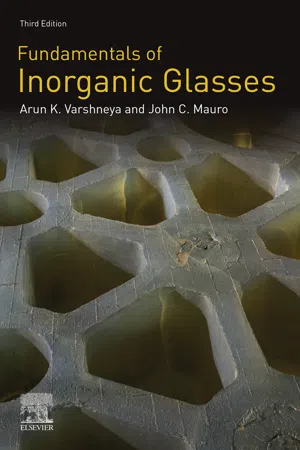
- 753 pages
- English
- ePUB (mobile friendly)
- Available on iOS & Android
Fundamentals of Inorganic Glasses
About this book
Fundamentals of Inorganic Glasses, Third Edition, is a comprehensive reference on the field of glass science and engineering that covers numerous, significant advances. This new edition includes the most recent advances in glass physics and chemistry, also discussing groundbreaking applications of glassy materials. It is suitable for upper level glass science courses and professional glass scientists and engineers at industrial and government labs. Fundamental concepts, chapter-ending problem sets, an emphasis on key ideas, and timely notes on suggested readings are all included. The book provides the breadth required of a comprehensive reference, offering coverage of the composition, structure and properties of inorganic glasses.- Clearly develops fundamental concepts and the basics of glass science and glass chemistry- Provides a comprehensive discussion of the composition, structure and properties of inorganic glasses- Features a discussion of the emerging applications of glass, including applications in energy, environment, pharmaceuticals, and more- Concludes chapters with problem sets and suggested readings to facilitate self-study
Frequently asked questions
- Essential is ideal for learners and professionals who enjoy exploring a wide range of subjects. Access the Essential Library with 800,000+ trusted titles and best-sellers across business, personal growth, and the humanities. Includes unlimited reading time and Standard Read Aloud voice.
- Complete: Perfect for advanced learners and researchers needing full, unrestricted access. Unlock 1.4M+ books across hundreds of subjects, including academic and specialized titles. The Complete Plan also includes advanced features like Premium Read Aloud and Research Assistant.
Please note we cannot support devices running on iOS 13 and Android 7 or earlier. Learn more about using the app.
Information
Introduction
Abstract
Keywords
1.1 Brief history
Table of contents
- Cover image
- Title page
- Table of Contents
- Copyright
- Dedication
- Preface
- Acknowledgments
- Chapter 1: Introduction
- Chapter 2: Fundamentals of the glassy state
- Chapter 3: Glass formation principles
- Chapter 4: Glass microstructure: Phase separation and liquid immiscibility
- Chapter 5: Glass compositions and structures
- Chapter 6: Composition-structure-property relationship principles
- Chapter 7: Density and molar volume
- Chapter 8: Elastic properties and hardness of glass
- Chapter 9: The viscosity of glass
- Chapter 10: Thermal expansion of glass
- Chapter 11: Heat capacity of glass
- Chapter 12: Thermal conductivity and acoustic properties of glass
- Chapter 13: Glass transition range behavior
- Chapter 14: Permeation, diffusion, and ionic conduction in glass
- Chapter 15: Dielectric properties
- Chapter 16: Electronic conduction
- Chapter 17: Chemical durability
- Chapter 18: Strength and toughness
- Chapter 19: Optical properties
- Chapter 20: Glass surfaces
- Chapter 21: Modeling of glass
- Chapter 22: Fundamentals of inorganic glass making
- Chapter 23: Emerging applications of glass
- Appendix: Elements of linear elasticity
- Index